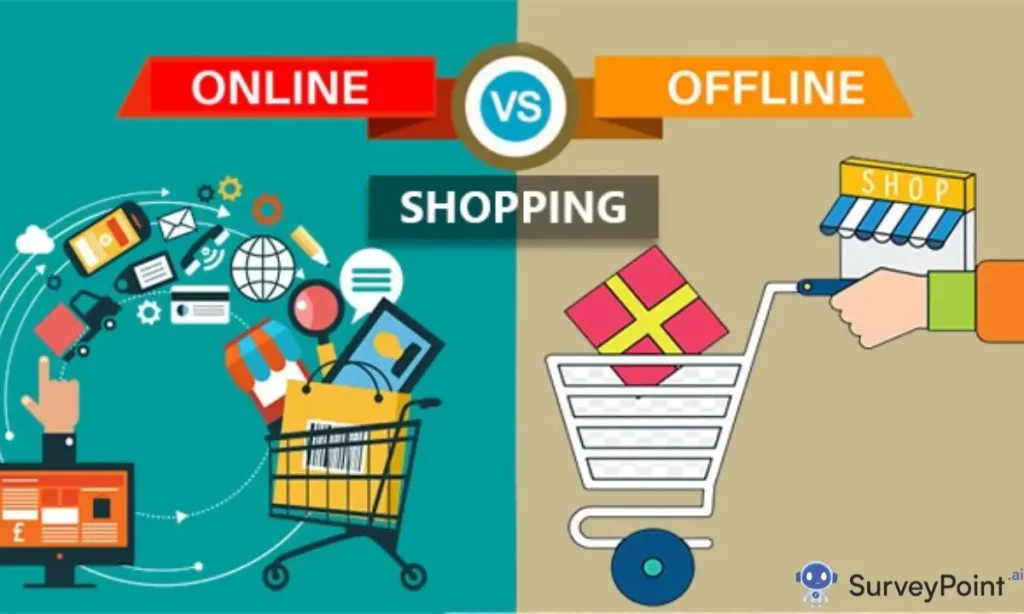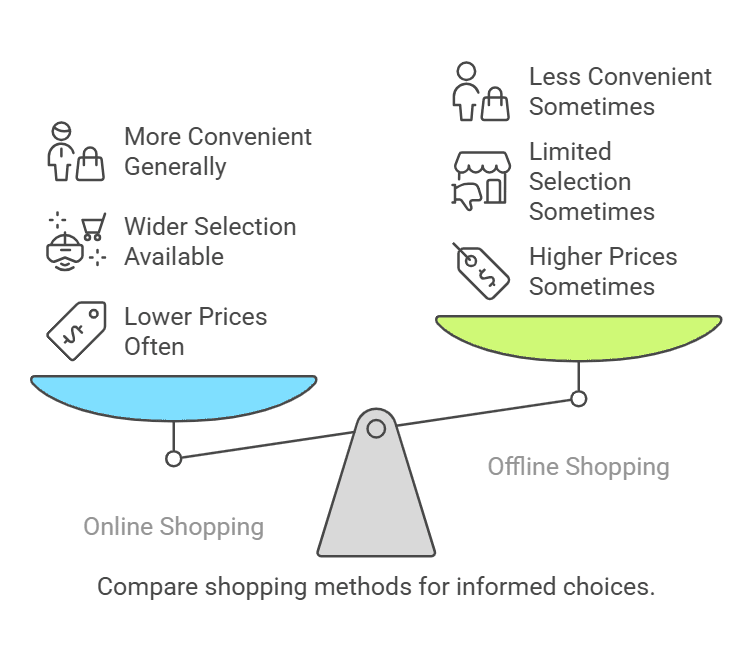
Shopping it’s a part of life we all experience, whether we’re grabbing groceries or splurging on a new gadget. But these days, you’ve got two big options: online shopping or offline shopping. Which one’s better? That depends on you, your needs, and what you value most.
The rise of e-commerce has flipped the retail world upside down. Meanwhile, brick-and-mortar stores still hold their ground with that hands-on charm. In this deep dive, we’ll break down everything convenience, cost, experience, and more so you can decide what works best for you.
Shopping isn’t what it used to be. Back in the day, you’d stroll into a store, chat with a clerk, and walk out with your goods. Now? You can order a couch from your phone while sipping coffee at home.
Online shopping has exploded think Amazon, eBay, and countless niche sites. Offline shopping, though, still thrives in malls, local markets, and specialty stores. Both have their fans, and both have their quirks.
This blog isn’t about picking a winner. It’s about giving you the full scoop so you can shop smarter, whether you’re clicking “add to cart” or browsing aisles.
What Is Online Shopping?
How It Works
Online shopping is simple: you visit a website or app, browse products, and buy with a few clicks. Your order ships to your door—or sometimes a pickup point. Platforms like Shopify and Etsy make it easy for small businesses to join the game too.
Key Benefits
The biggest perk? Convenience. Shop anytime, anywhere—no need to leave your couch. You also get endless variety—think rare books or custom jewelry you’d never find locally.
Price comparison is a breeze online. A quick search shows you who’s got the best deal. Plus, digital coupons and flash sales can save you a bundle.
Common Drawbacks
You can’t touch or try stuff before buying. That dress might look amazing online but fit like a potato sack. Shipping delays and costs can also sting—especially if you’re in a hurry.
Fraud’s another worry. Shady sites can scam you, and returns can be a hassle if the seller’s overseas. It’s not all bad, but it’s not perfect either.

What Is Offline Shopping?
How It Works
Offline shopping means heading to a physical store. You walk in, see the goods, maybe chat with staff, and leave with your purchase. Think grocery runs, mall trips, or hitting up a local boutique.
Key Benefits
You get instant gratification—buy it, take it home, done. Seeing and feeling products firsthand is huge especially for clothes or furniture. Plus, there’s no shipping wait.
Personal interaction shines here. A friendly salesperson can answer questions or suggest alternatives. For some, that human touch beats a chatbot any day.
Common Drawbacks
It’s time-consuming. Driving, parking, and wandering aisles eats up your day. Selection’s limited too—what’s on the shelf is what you get, no more, no less.
Prices might be higher since stores have overhead costs like rent and staff wages. And good luck finding a deal if there’s no sale running.
Online Shopping vs Offline Shopping: A Head-to-Head Comparison
Convenience
Online wins hands down. Shop at 2 a.m. in your pajamas? No problem. Offline shopping requires effort—travel, crowds, and store hours can cramp your style.
Need something fast? Offline’s your friend. Walk in, grab it, go. Online’s delivery timelines can’t compete with that immediacy.
Price and Deals
Online often edges out with lower prices. No physical storefront means lower costs, and competition drives discounts. Flash sales and promo codes sweeten the pot.
Offline can surprise you, though. Clearance racks and in-store-only deals sometimes beat online prices. Haggling works in some spots too—like flea markets.
Product Selection
Online’s variety is unmatched. From global brands to handmade crafts, it’s all there. Filters and reviews help you sift through the noise.
Offline’s limited by shelf space. Big stores like Walmart have a lot, but niche or out-of-stock items? You’re out of luck unless you hunt another location.

Experience and Trust
Offline offers sensory appeal—smell a candle, test a mattress, try on shoes. That builds trust. You know exactly what you’re getting.
Online’s a leap of faith. Photos and reviews guide you, but fakes and flops happen. Reputable sites like Amazon are safer, but smaller shops? Roll the dice.
Returns and Support
Offline returns are straightforward—bring it back, get a refund. Staff can troubleshoot issues on the spot, no email chains required.
Online returns vary. Some offer free shipping back; others make you pay. Customer service can be a lifeline—or a nightmare if it’s just bots.
People Also Ask (PAA) Questions
Is Online Shopping Cheaper Than Offline Shopping?
Often, yes. Online retailers skip the middleman and overhead, passing savings to you. Deals like Black Friday online exclusives amplify that.
But offline can compete. Local sales, bulk buys, or haggling might tip the scales. It’s about timing and where you shop.
What Are the Disadvantages of Offline Shopping?
Time’s the big one—travel and crowds slow you down. Limited stock frustrates, and prices might not budge without a sale.
Weather’s a factor too. Rainy days or heatwaves make store trips a chore. Online shoppers dodge that hassle entirely.
How Does Online Shopping Affect Local Stores?
It’s a double-edged sword. E-commerce pulls customers away, hurting small businesses that can’t compete with giants like Amazon. Foot traffic’s down in many towns.
Yet some stores adapt—offering unique experiences or hybrid online-offline models. It’s survival of the savviest.
Can You Trust Online Shopping Websites?
Mostly, yes—if you stick to known names like Target or Etsy. Check reviews, secure payment icons (that little lock in the URL), and avoid sketchy pop-up ads.
Scams exist, though. A deal too good to be true probably is. Research before clicking “buy” on unfamiliar sites.
Which Is Faster: Online or Offline Shopping?
Offline’s instant—you leave with your item. Online depends on shipping. Same-day delivery’s growing, but it’s not everywhere yet.
For urgent needs, offline wins. For planned buys, online’s pace is fine—especially with subscriptions or bulk orders.
Tips for Smarter Shopping (Online and Offline)
Online: Use price trackers like Honey to snag deals. Read reviews—skip the five-star spam and dig into the three-star ones for real talk. Double-check return policies.
Offline: Shop during off-hours to avoid crowds. Ask staff about unadvertised discounts—some stores hold back deals for in-person buyers. Bring a list to stay focused.
Both: Set a budget. Impulse buys hit hard, whether it’s a checkout candy bar or a “limited time” online pop-up.

The Future of Shopping: Hybrid Models
The lines are blurring. Stores like Walmart now offer curbside pickup—shop online, grab it offline. Amazon’s testing physical “Go” stores with no cashiers.
Augmented reality (AR) lets you “try” online furniture in your room. Offline shops are adding QR codes for instant online reviews. It’s the best of both worlds.
Expect more of this. Convenience, variety, and experience will mash up as tech evolves. Shopping’s not dying—it’s just changing.
Conclusion: Which Should You Choose?
Online shopping’s your go-to for convenience, variety, and often price. It’s perfect for busy schedules or hard-to-find items. Offline shines when you need it now or want that personal touch.
Me? I mix it up. Groceries offline, gadgets online—it’s about what fits the moment. Think about your priorities: time, cost, or experience. That’s your answer.
So, next time you shop, weigh your options. Both have their magic—you just need to pick your flavor.




